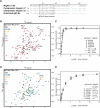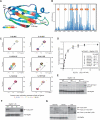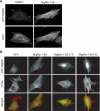Structural basis of the migfilin-filamin interaction and competition with integrin beta tails
- PMID: 18829455
- PMCID: PMC2596399
- DOI: 10.1074/jbc.M802592200
Structural basis of the migfilin-filamin interaction and competition with integrin beta tails
Abstract
A link between sites of cell adhesion and the cytoskeleton is essential for regulation of cell shape, motility, and signaling. Migfilin is a recently identified adaptor protein that localizes at cell-cell and cell-extracellular matrix adhesion sites, where it is thought to provide a link to the cytoskeleton by interacting with the actin cross-linking protein filamin. Here we have used x-ray crystallography, NMR spectroscopy, and protein-protein interaction studies to investigate the molecular basis of migfilin binding to filamin. We report that the N-terminal portion of migfilin can bind all three human filamins (FLNa, -b, or -c) and that there are multiple migfilin-binding sites in FLNa. Human filamins are composed of an N-terminal actin-binding domain followed by 24 immunoglobulin-like (IgFLN) domains and we find that migfilin binds preferentially to IgFLNa21 and more weakly to IgFLNa19 and -22. The filamin-binding site in migfilin is localized between Pro(5) and Pro(19) and binds to the CD face of the IgFLNa21 beta-sandwich. This interaction is similar to the previously characterized beta 7 integrin-IgFLNa21 interaction and migfilin and integrin beta tails can compete with one another for binding to IgFLNa21. This suggests that competition between filamin ligands for common binding sites on IgFLN domains may provide a general means of modulating filamin interactions and signaling. In this specific case, displacement of integrin tails from filamin by migfilin may provide a mechanism for switching between different integrin-cytoskeleton linkages.
Figures







Similar articles
-
Migfilin, a molecular switch in regulation of integrin activation.J Biol Chem. 2009 Feb 13;284(7):4713-22. doi: 10.1074/jbc.M807719200. Epub 2008 Dec 13. J Biol Chem. 2009. PMID: 19074766 Free PMC article.
-
The molecular basis of filamin binding to integrins and competition with talin.Mol Cell. 2006 Feb 3;21(3):337-47. doi: 10.1016/j.molcel.2006.01.011. Mol Cell. 2006. PMID: 16455489
-
Structure of three tandem filamin domains reveals auto-inhibition of ligand binding.EMBO J. 2007 Sep 5;26(17):3993-4004. doi: 10.1038/sj.emboj.7601827. Epub 2007 Aug 9. EMBO J. 2007. PMID: 17690686 Free PMC article.
-
Mechanisms that regulate adaptor binding to beta-integrin cytoplasmic tails.J Cell Sci. 2009 Jan 15;122(Pt 2):187-98. doi: 10.1242/jcs.041624. J Cell Sci. 2009. PMID: 19118211 Review.
-
Structural portrait of filamin interaction mechanisms.Curr Protein Pept Sci. 2010 Nov;11(7):639-50. doi: 10.2174/138920310794109111. Curr Protein Pept Sci. 2010. PMID: 20887254 Review.
Cited by
-
SOX11 and SOX4 drive the reactivation of an embryonic gene program during murine wound repair.Nat Commun. 2019 Sep 6;10(1):4042. doi: 10.1038/s41467-019-11880-9. Nat Commun. 2019. PMID: 31492871 Free PMC article.
-
Migfilin: Cell Adhesion Effect and Comorbidities.Onco Targets Ther. 2022 Apr 19;15:411-422. doi: 10.2147/OTT.S357355. eCollection 2022. Onco Targets Ther. 2022. PMID: 35469339 Free PMC article. Review.
-
Atomic structures of two novel immunoglobulin-like domain pairs in the actin cross-linking protein filamin.J Biol Chem. 2009 Sep 11;284(37):25450-8. doi: 10.1074/jbc.M109.019661. Epub 2009 Jul 21. J Biol Chem. 2009. PMID: 19622754 Free PMC article.
-
HspB1 phosphorylation regulates its intramolecular dynamics and mechanosensitive molecular chaperone interaction with filamin C.Sci Adv. 2019 May 22;5(5):eaav8421. doi: 10.1126/sciadv.aav8421. eCollection 2019 May. Sci Adv. 2019. PMID: 31131323 Free PMC article.
-
Integrin Regulation in Immunological and Cancerous Cells and Exosomes.Int J Mol Sci. 2021 Feb 23;22(4):2193. doi: 10.3390/ijms22042193. Int J Mol Sci. 2021. PMID: 33672100 Free PMC article. Review.
References
-
- Evans, E. A., and Calderwood, D. A. (2007) Science 316 1148-1153 - PubMed
-
- Tu, Y., Wu, S., Shi, X., Chen, K., and Wu, C. (2003) Cell 113 37-47 - PubMed
-
- Takafuta, T., Saeki, M., Fujimoto, T. T., Fujimura, K., and Shapiro, S. S. (2003) J. Biol. Chem. 278 12175-12181 - PubMed
-
- Wu, C. (2005) J. Cell Sci. 118 659-664 - PubMed
Publication types
MeSH terms
Substances
Grants and funding
LinkOut - more resources
Full Text Sources
Molecular Biology Databases
Miscellaneous

